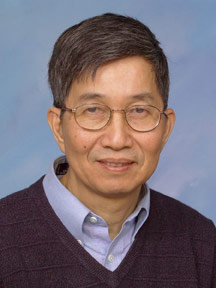Ching Wan Tang: Difference between revisions
No edit summary |
No edit summary |
||
| (3 intermediate revisions by 2 users not shown) | |||
| Line 1: | Line 1: | ||
{{Biography | |||
|Image=Tang.jpg | |||
|Associated organizations=Eastman Kodak Research Laboratories | |||
|Fields of study=LEDs | |||
}} | |||
[[Stephen R. Forrest]], [[Richard Friend]] and Ching Tang have amassed a substantial list of accomplishments in the field of light-emitting diodes. The three Noble Award co-recipients have conducted pioneering research with organic light-emitting diodes (OLEDs) that has resulted in the development and quick commercialization of flat-panel displays. Their work is present in today’s state of the art high definition televisions and also is beginning to be incorporated in common portable electronic devices. Today, more than 85 companies have brought flat-panel displays to market as a result of the developments driven by these three gentlemen. OLED displays are becoming increasingly popular and also are beginning to replace small liquid crystal displays (LCDs) in handheld electronics such as cell phones, MP3 players and digital cameras because they consume less power, are thinner and lighter and can be made using inexpensive manufacturing processes such as inkjet printing. OLEDs also have exceptional video image qualities that have enhanced the quality of solid-state general lighting. | [[Stephen R. Forrest]], [[Richard Friend]] and Ching Tang have amassed a substantial list of accomplishments in the field of light-emitting diodes. The three Noble Award co-recipients have conducted pioneering research with organic light-emitting diodes (OLEDs) that has resulted in the development and quick commercialization of flat-panel displays. Their work is present in today’s state of the art high definition televisions and also is beginning to be incorporated in common portable electronic devices. Today, more than 85 companies have brought flat-panel displays to market as a result of the developments driven by these three gentlemen. OLED displays are becoming increasingly popular and also are beginning to replace small liquid crystal displays (LCDs) in handheld electronics such as cell phones, MP3 players and digital cameras because they consume less power, are thinner and lighter and can be made using inexpensive manufacturing processes such as inkjet printing. OLEDs also have exceptional video image qualities that have enhanced the quality of solid-state general lighting. | ||
Dr. Tang is Doris Johns Cherry Professor of Chemical Engineering at the University of Rochester in Rochester, N.Y., and senior research associate and group leader of OLED Research at Eastman Kodak Research Laboratories. Dr. Tang is a Fellow of the American Physical Society, a Fellow of the Society for Information Display, and a member of the National Academy of Engineering. | Dr. Tang is Doris Johns Cherry Professor of Chemical Engineering at the University of Rochester in Rochester, N.Y., and senior research associate and group leader of OLED Research at Eastman Kodak Research Laboratories. Dr. Tang is a Fellow of the American Physical Society, a Fellow of the Society for Information Display, and a member of the National Academy of Engineering. | ||
[[Category: | [[Category:Light emitting diodes]] | ||
{{DEFAULTSORT:Tang}} | |||
Latest revision as of 18:51, 20 January 2016
- Associated organizations
- Eastman Kodak Research Laboratories
- Fields of study
- LEDs
Biography
Stephen R. Forrest, Richard Friend and Ching Tang have amassed a substantial list of accomplishments in the field of light-emitting diodes. The three Noble Award co-recipients have conducted pioneering research with organic light-emitting diodes (OLEDs) that has resulted in the development and quick commercialization of flat-panel displays. Their work is present in today’s state of the art high definition televisions and also is beginning to be incorporated in common portable electronic devices. Today, more than 85 companies have brought flat-panel displays to market as a result of the developments driven by these three gentlemen. OLED displays are becoming increasingly popular and also are beginning to replace small liquid crystal displays (LCDs) in handheld electronics such as cell phones, MP3 players and digital cameras because they consume less power, are thinner and lighter and can be made using inexpensive manufacturing processes such as inkjet printing. OLEDs also have exceptional video image qualities that have enhanced the quality of solid-state general lighting.
Dr. Tang is Doris Johns Cherry Professor of Chemical Engineering at the University of Rochester in Rochester, N.Y., and senior research associate and group leader of OLED Research at Eastman Kodak Research Laboratories. Dr. Tang is a Fellow of the American Physical Society, a Fellow of the Society for Information Display, and a member of the National Academy of Engineering.
